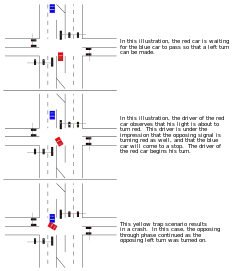Yellow trap
In right-hand traffic, the yellow trap is a potentially dangerous scenario in traffic flow through a traffic light relating to permissive left turns. It occurs when a circular yellow light is displayed to a movement with permissive left turns, while at the same time, opposing through traffic still has a circular green light. Some drivers facing the circular yellow (then red) lights will assume the opposite direction faces the same color display, and that oncoming traffic will stop.[1] This leads to potential traffic conflict if drivers attempt to complete a left turn when it is not safe to do so. The left-turning driver may legally be at fault, for failure to yield, but made an understandable mistake.[2]

Solutions to the yellow trap include the flashing yellow arrow, Dallas phasing, Arlington phasing, simultaneously ending both through movements (circular green lights change to yellow, then red) before serving both left-turn movements (green arrows), or prohibiting one of the two left-turn movements.
Many agencies in North America routinely allow the yellow trap, especially during emergency vehicle preemption, despite clear prohibition from the Manual on Uniform Traffic Control Devices. The MUTCD allows this sequence only if a sign reading '''Oncoming Traffic Has Extended Green''' or '''Oncoming Traffic May Have Extended Green''' is posted.[3] Some of this stems from difficulties programming older traffic signal control software to prevent the yellow trap, but much stems from traffic engineers or technicians not understanding the yellow trap hazard, or believing it is not a serious problem.
In left-hand traffic, the same scenario is applicable for drivers turning right.
References
- "Frequently Asked Questions – Part 4 – Highway Traffic Signals". Federal Highway Administration. Retrieved February 10, 2019.
- Vigmond, Karen. "Yellow Light and Left Hand Turn Accidents – Who's at Fault?". Oatley Vigmond. Retrieved February 10, 2019.
- "Interpretation Letter 4-320(I) - Steady Yellow Arrow After Flashing Yellow Arrow". Federal Highway Administration. Retrieved February 10, 2019.
